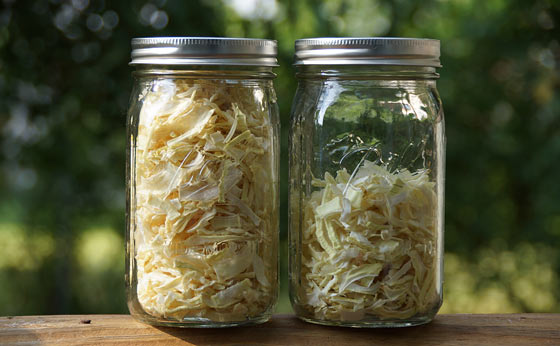How to Dehydrate Onions for Long Term Storage

Onions can store for quite a bit of time if they are prepared and kept in a cool and dark place, such as a root cellar. However, they can also sprout or start to rot if they are exposed to moisture and warmer temperatures. Dehydration is one of the best methods to use if you want to store onions for more than a month or two. The process is pretty straightforward, but it’s not foolproof. The following technique is known to make it easier to remove moisture from onions, and this is great way to add them to your food stockpile.
Getting Started
The first thing to do is make sure that you process the onions in a well-ventilated place, preferably outside. The smell, as well as the tears that well up as the onions are being prepared and dehydrating will be overwhelming. The next thing to consider is that you need a food dehydrator for this recipe. Don’t use an oven or any other method of dehydrating as temperatures need to be controlled at levels that are almost impossible to manage without a dehydrator.
The first step is to cut off the heads and tails of the onions, and let the trimmed bulbs soak in a container filled with fresh, cool water. You can leave the skins on. Keep soaking the onions as you process this recipe, and only remove them from the water, one by one, as you prepare them for the dehydrator. It’s also important to soak small batches at a time, using just enough to fill up the dehydrator.
Processing the Onions
One of the biggest mistakes that people make when dehydrating onions is they cut them into rings. Rings have a large surface area, and this can inhibit the complete removal of moisture. Rings can also cause some pieces to be drier than others, leaving you with an inconsistent finished product. This can dramatically increase the processing time and make it more labor-intensive as you need to separate the dried parts from the moist ones before dehydrating again.
The best thing to do is to cut the onions into small, thin pieces. Some people like to use a food processor, but you should consider dicing them instead. Dicing will give you pieces that are more consistent in size, and this is key to efficient dehydration. A food processor will produce pieces that vary in size, and you will also end up with a lot of mush when finished as well. When finished, set the diced onions aside.
The next step is to place some wax paper on top of the dehydration tray. Poke a hole in the center so the paper will slide over the center stub of the dehydrator, but you don’t need to poke holes throughout the paper. Next, place the onions atop the paper in a single layer, spreading them out as much as possible based on how many pieces you are using. The idea is to create small pockets where air can move through as the dehydration process unfolds. Giving the onions room to breathe will also play a big role in the quality and consistency of the finished product.
Next, turn the temperature of the dehydrator to about 135 degrees and let the onions dry out for around 12 hours. Some people have been able to dehydrate the onions in as little as 6 hours, but this is usually only possible in areas that have very low humidity in the air. Being patient is key to having a perfect product once the process is complete.
All you need to do now is place the onions into a zipper freezer bag before labeling and dating each one. Just make sure that the onions are completely dry before removing from the dehydrator and packing. You can also use mason jars or other airtight containers as well. If you are working with fresh onions that have not had time to “cure”, then use freezer bags to store the finished product, and place them in a freezer for about two weeks before placing them in an airtight container.
To rehydrate them, simply soak the onions in water until they soften or place the pieces directly into the liquids that you are cooking with. While dehydrating onions may involve some trial and error at first, you will quickly learn the nuances of how to process them. Try this out for yourself and see how this method can give you a long-term supply of onions that can safely be stored in your stockpile.
